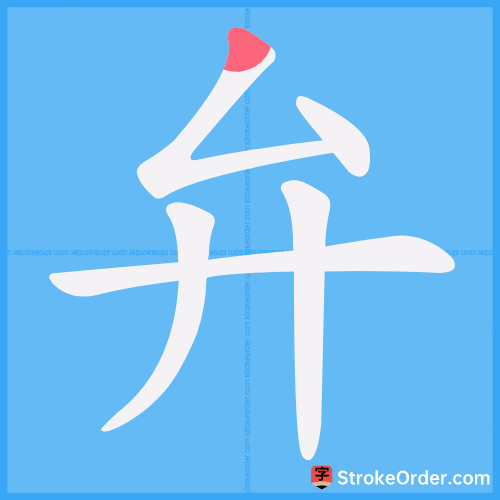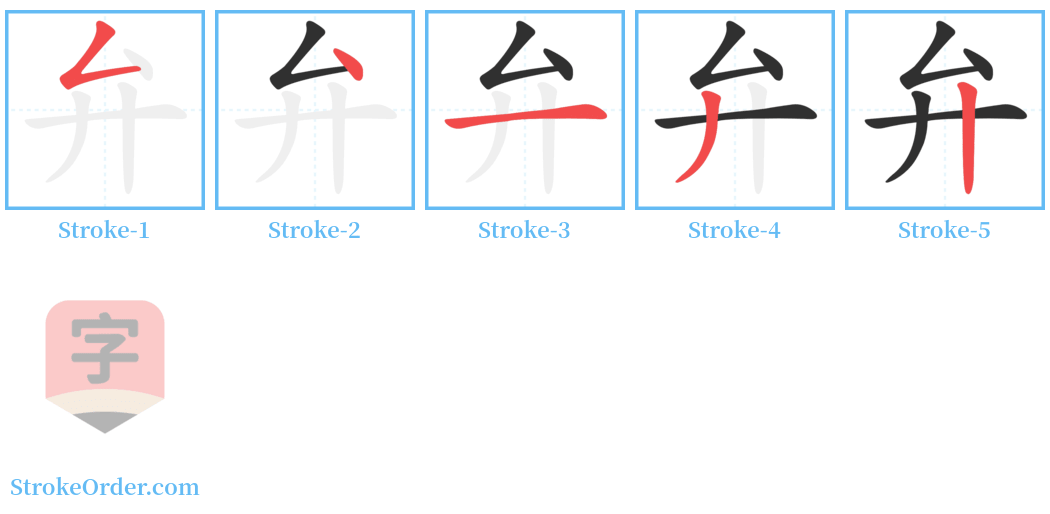弁 Stroke Order
Animated Stroke Order of 弁

Stroke Order Diagrams for 弁

Step-by-Step Handwriting Guide for 弁

Learn to Write Chinese Characters with Video Tutorials
Watch the video of writing the Chinese character "弁", learn the correct stroke order (笔顺) of the character "弁", and master the standard way of writing the character "弁".
Free Printable Handwriting Practice with Stroke Order: 弁
Printable Writing Practice Worksheet of "弁" in Portrait Orientation (Tian Zi Ge)

Printable Writing Practice Worksheet of "弁" in Landscape Orientation (Tian Zi Ge)

Information of 弁
Pinyin
biàn
Radical
廾
Strokes
5 strokes
Usage
★★★★
Definition
cap
弁
Pronunciation: biàn
Part of Speech: [Noun]
1. A type of hat worn in ancient times.
2. (弁言) The preface or introduction of a book or lengthy article.
3. The term used in ancient times for low-ranking military officers.
1. A type of official hat in ancient times, usually worn with ceremonial clothing (the cap for auspicious ceremonies). The cap made from red-black cloth is called 爵弁 (juè biàn), a civil crown; while the one made from white deer hide is called 皮弁 (pí biàn), a military crown. Later, it generally refers to hats. [En. crown; cap]
2. In ancient times, it referred to military officers, specifically those who wore leather hats, later specifically denoting low-ranking military officers. [En. a low ranking military officer]
弁
Pronunciation: biàn
Part of Speech: [Verb]
1. In ancient times, when a man reached the age of twenty and put on a hat, it was called 弁, signifying adulthood. [En. put on a man's hat]
2. To crown the head. [En. put at the head]
3. To place in front. [En. put before]
弁
Pronunciation: biàn
Part of Speech: [Adjective]
Fast (English: fast; at high speed)
弁
Pronunciation: biàn
Part of Speech: [Noun]
1. A type of official hat in ancient times, usually worn with ceremonial clothing (the cap for auspicious ceremonies). The cap made from red-black cloth is called 爵弁 (juè biàn), a civil crown; while the one made from white deer hide is called 皮弁 (pí biàn), a military crown. Later, it generally refers to hats. [En. crown; cap]
1. The term used in ancient texts defines a hat: “弁” is a term for the crown in various dynasties. The cap style varies from the Zhou to the Yin and Xia dynasties.
2. The term “弁” refers to the large style of ancient caps. The “纟” (silk) cloth categorized a crown.
3. In the Book of Rites, a leather hat was noted as being crafted from white deer hide.
4. The rhyme records that “弁” is the name of the Zhou crown.
5. The Book of Songs mentions the phrase “突而弁兮.”
6. In the Book of Documents, it quotes “Kings and nobles wore hats.”
7. References in the Zuo Tradition record events of not wearing hats during confrontations.
As an example:
弁师 (biàn shī): an ancient ceremonial official overseeing caps.
弁冕 (biàn miǎn): the ceremonial hat worn in ancient times, typically denotes a leader or chief in a metaphorical sense.
2. Specifically indicating low-ranking military officers, as they wore leather hats; also refers to soldiers known as 弁目 during the Qing dynasty.
弁
Pronunciation: biàn
Part of Speech: [Verb]
1. Denoting a man reaching adulthood when he turns twenty and wears a hat. [En. put on a man's hat]
2. To crown the head. [En. put at the head]
3. To place in front. [En. put before]
As an example:
弁丁 (biàn dīng) denotes laborers or workmen during the Qing period.
弁
Pronunciation: biàn
Part of Speech: [Adjective]
Fast (English: fast; at high speed)
As referenced in the Book of Han: “I am very fast.”
(*Quoted from the traditional dictionary explanation)
Part of Speech: [Adjective]
1. Joyful, merry. (In the Book of Songs, “弁彼鸒斯,歸飛提提.” implies singing in joy. In the Han dynasty commentary, it clarifies that “弁” indeed signifies joy.)
Input Method for 弁
Pinyin
bian4
Wubi
caj
Cangjie
it
Zhengma
zse
Four Corner
23440
Unicode
U+5f01
Same Pronunciation Characters